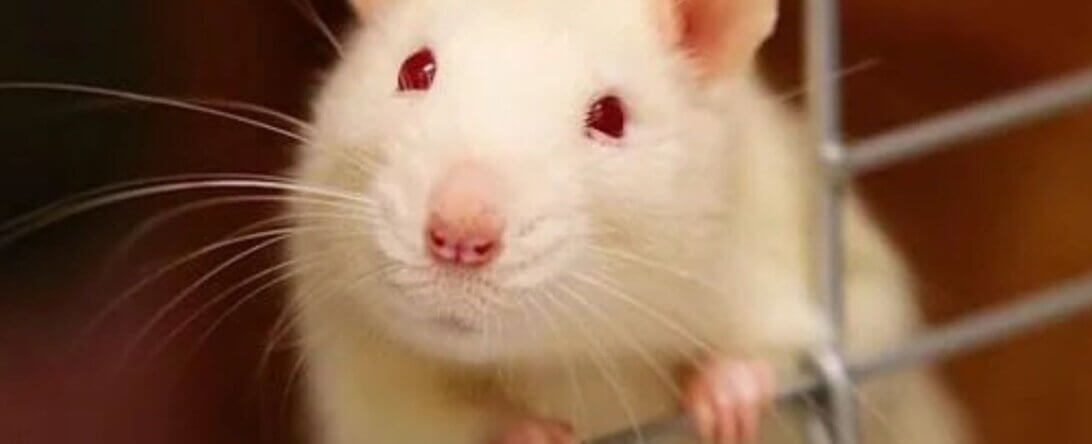Why Animal Testing Needs to Take Several Seats
Animal testing doesn’t involve giving Advil to dogs or putting blush on a rabbit’s face. It often consists of poisoning, shocking, burning, addicting to drugs, starving, isolating, brain-damaging, restraining, mutilating, or psychologically distressing animals who spend their lives confined to small cages inside windowless laboratories—and then killing and dissecting them.
Here are five reasons why animal testing needs to be canceled immediately:
- It’s Unethical
It’s wrong to keep millions of sensitive animals in cages and subject them to a life of pain, loneliness, and fear. Periodt. Did you know that no experiment, no matter how trivial or painful it may be, is illegal? Callous people dressed in lab coats are allowed to do whatever they want to animals, with no accountability. And get this: In the U.S., mice, rats, birds, fish, reptiles, and amphibians make up 99% of the animals in laboratories—and they’re all exempt from the minimal welfare standards of the federal Animal Welfare Act.
If you’re thinking that surely some government agency is checking up on the animals being used at least, say less. There are more than 11,000 facilities regulated by the U.S. Department of Agriculture (USDA), including more than 1,200 designated for “research,” and only 120 USDA inspectors to oversee all of them. Usually this means just one inspection per facility each year.
- It Simply Doesn’t Work
Using animals in experiments is bad science. The National Institutes of Health (NIH) reports that 95% of drugs that pass animal tests fail in humans. If 5% accuracy in your chosen field is the best you can do, you might be an idiot. We’re looking at you, animal experimenters. Studies have found that chemicals that caused cancer in rats caused cancer in mice less than 50% percent of the time. If we can’t even get reliable data between rats and mice, we obviously can’t seriously expect test results from mice, monkeys, guinea pigs, dogs, and rabbits to have anything to do with humans. A 2014 review published in The BMJ found that “even the most promising findings from animal-based research often fail in human trials and are rarely adopted into clinical practice.”
Artificially inducing a condition in animals that they would otherwise never have developed, keeping them in an unnatural and stressful environment void of sunlight and fresh air, and trying to apply the results to naturally occurring diseases in humans is utter nonsense. Up to 89% of preclinical studies, a large part of which involves animal experiments, can’t be reproduced. Reproducibility is a fundamental step needed to confirm the validity of scientific results. The invalid salad that is animal experimentation is one of the biggest ongoing hoaxes of our time.
- It’s Totally Useless
While some experimenters pretend that their cruel tests on animals might lead to treatments or cures for humans one day (which is pure cap), many experiments on animals don’t even claim to be relevant to humans! These blatantly useless tests are known as “curiosity-driven experiments”—because they’re done out of sheer curiosity. Most of them are just slight variations of ones that have already been conducted for years, and the “results” are so obvious—like if you sew a baby monkey’s eyes shut and don’t let them see any faces, they suffer brain damage. We knew this.
- It’s a Big Fat WASTE of Everything
Animal experiments prolong the suffering of humans waiting for cures and effective treatments because the results mislead experimenters and squander resources that could have been spent on human-relevant research. Did you know we cured many types of cancer in mice half a century ago? It doesn’t work on humans. Gahsp! Experiments on animals are largely funded by taxpayers. In this economy?! Yes. Nearly half of NIH-funded research involves animal experiments, and in 2021, that meant more than $21 billion was wasted. Worst of all is that right now there are about 110 million animals being used in horrific experiments that only a truly sick person could come up with and that all their lives will go to waste.
- It’s Completely Unnecessary
Cutting-edge, non-animal research methods are pushin’ P and are far more accurate than animal experiments. Human-relevant methods include organs-on-chips that use human cells and tissues (in vitro methods), advanced computer-modeling techniques (in silico models), and studies with human volunteers. These and other non-animal methods aren’t hindered by species differences that make applying results to humans unreliable and even impossible—and they usually take less time and money to complete.
A Pew Research Center poll found that the majority of Americans don’t stan animal experiments. They’re so worthless that results from up to half of them are never even published. Pass these five reasons along to anyone who doesn’t yet understand that tormenting animals in laboratories is an unnecessary evil.
Text peta2 to 30933 for ways to help animals, tips on compassionate living, and more!

Terms for automated texts/calls from peta2: http://peta.vg/txt. Text STOP to end, HELP for more info. Msg/data rates may apply. U.S. only.




